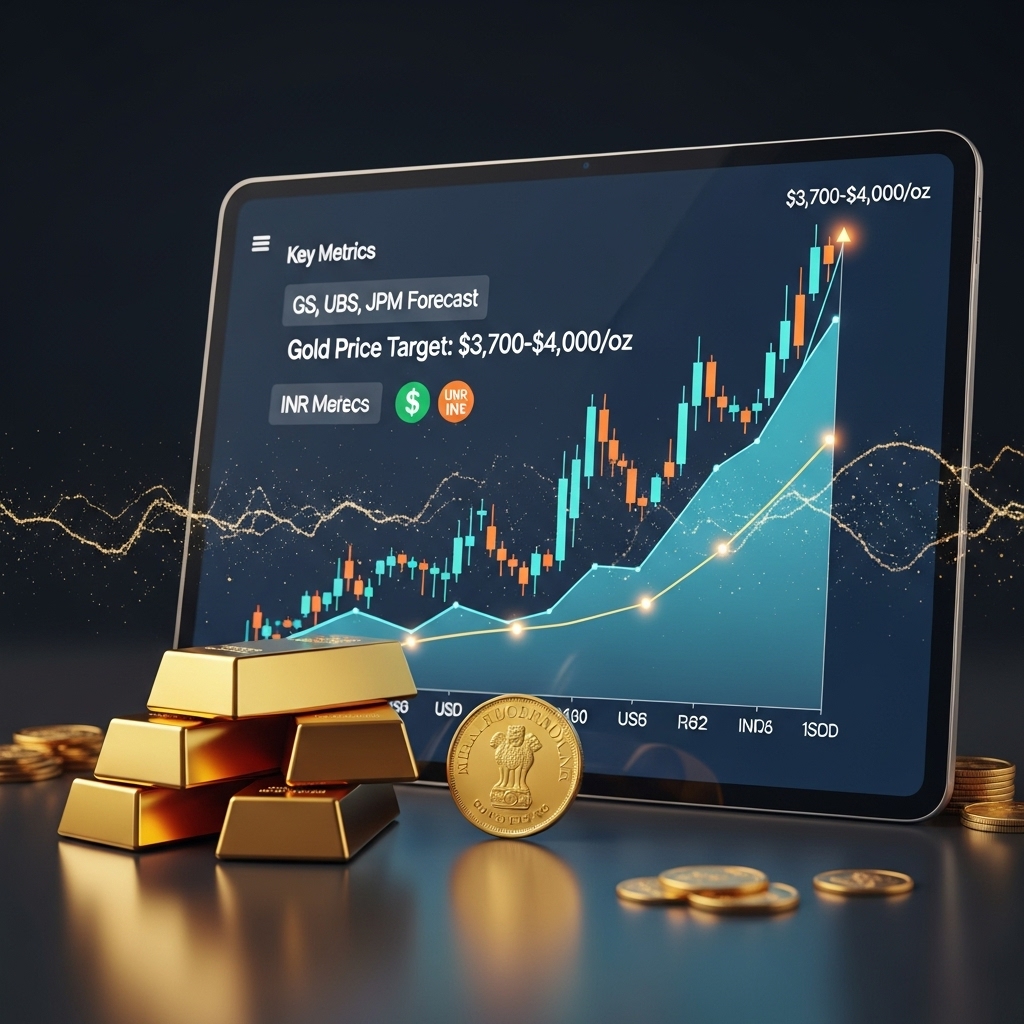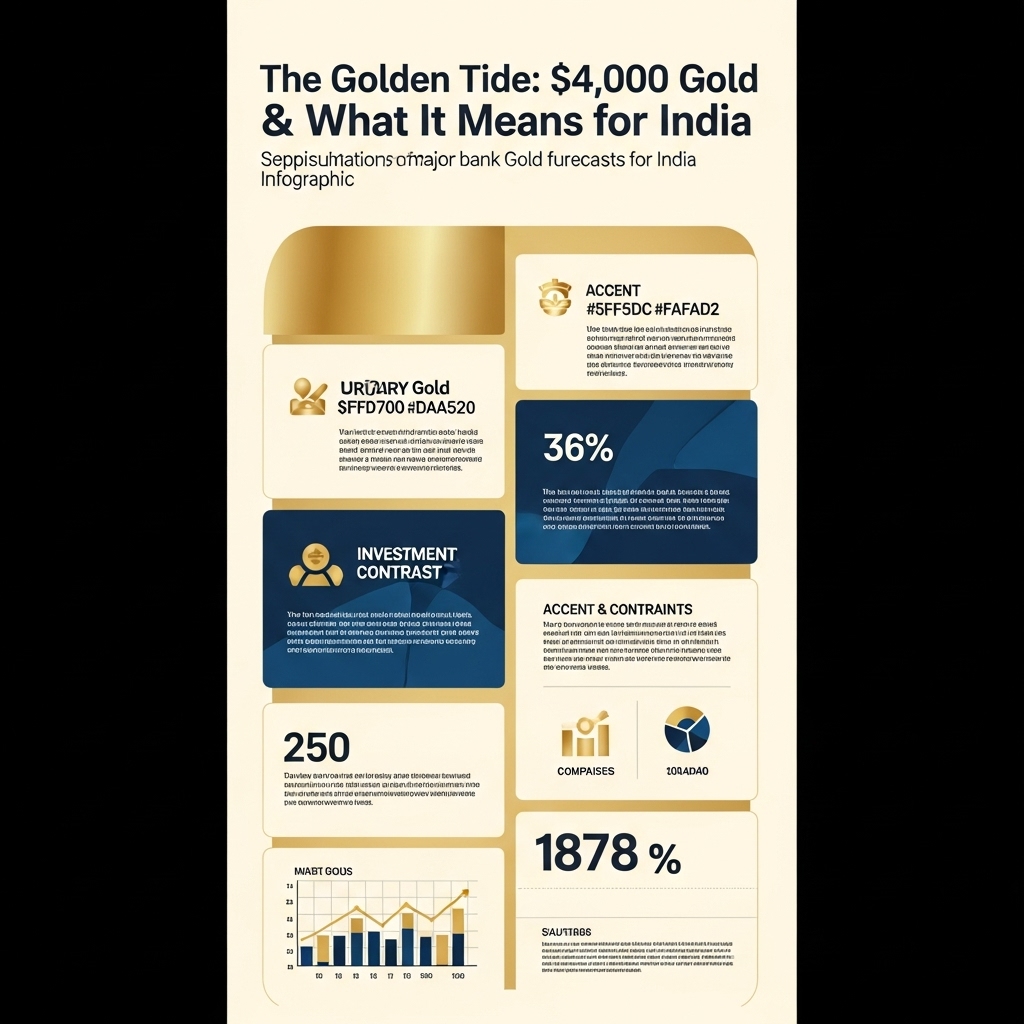Gold’s Golden Horizon: What $4,000/oz Means for Indian Investors
The financial world is abuzz with extraordinary predictions: market giants like Goldman Sachs, UBS, and JP Morgan are now forecasting gold prices to soar to an astonishing $3,700-$4,000 per ounce. This isn’t mere speculation; it’s a powerful signal from institutions known for deep analytical prowess, suggesting gold’s impressive rally could be just the beginning of a historic bull run. For discerning investors, accustomed to gold as a traditional safe haven, these forecasts elevate the yellow metal into a potentially significant engine for capital appreciation and portfolio growth.
So, what exactly is fueling these incredibly bullish outlooks, and what do these ambitious price targets signify for your investment strategy? Crucially, how will this potential surge impact gold’s role for investors in India, a nation deeply rooted in its affinity for gold as a store of wealth and cultural treasure? This post will meticulously break down the key market trends and macroeconomic forces underpinning these expert predictions. We’ll explore the intricate interplay of factors—from persistent inflation and geopolitical instability to unprecedented central bank buying—that are collectively paving the way for gold’s potential climb.
For any gold investor, understanding these dynamics is fundamental to making informed decisions. This analysis aims to illuminate the profound financial benefits of positioning your portfolio effectively, offering both enhanced wealth preservation and the potential for substantial capital gains. Discover how these pivotal forecasts from Wall Street’s elite could redefine your approach to gold investing, empowering you to capitalize on what promises to be an era of unparalleled value for this gleaming asset.
Gold Market Analysis and Key Insights
The recent bullish forecasts from leading financial institutions like Goldman Sachs, UBS, and JPMorgan, predicting gold prices to ascend to an unprecedented \$3,700-$4,000 per ounce, signal a profound shift in global market sentiment. This represents a substantial upside from current levels, highlighting gold’s enhanced role amidst economic uncertainties and geopolitical volatility.
Global Drivers and Price Trajectory
These ambitious targets are primarily underpinned by persistent global inflation concerns, ongoing geopolitical tensions (such as conflicts in Eastern Europe and the Middle East), and a softening US dollar outlook. Crucially, central banks worldwide are accumulating gold at an accelerating pace, with record purchases reported in recent years, reflecting a strategic move towards de-dollarization and reserve diversification. Current gold prices, hovering around the \$2,300-\$2,400/oz mark, suggest the projected targets represent a significant appreciation driven by these systemic shifts.
Implications for Indian Investors
For India, these forecasts hold immense significance. As the world’s second-largest gold consumer, the country’s demand is deeply rooted in cultural affinity and festival purchasing. A stronger global gold price, coupled with potential INR depreciation against the USD, could amplify returns for Indian investors in rupee terms. This scenario positions gold as a potentially robust hedge against domestic inflation and currency fluctuations, enhancing its appeal beyond traditional consumption.
Current Gold Market Trends and Data: The gold market has demonstrated resilience, frequently testing new all-time highs driven by safe-haven demand. Recent data indicates robust central bank buying continued through Q1 2024, with China’s central bank being a notable accumulator. Macroeconomic indicators, including inflation figures and interest rate expectations from major economies, continue to exert a strong influence, leading to periods of consolidation but maintaining an upward trajectory.
Investment Benefits and Considerations: Investing in gold offers diversification, acting as a reliable hedge against inflation and market downturns. However, investors must consider price volatility and the optimal investment vehicle. For Indian investors, options range from physical gold (with storage and purity concerns) to more liquid and tax-efficient alternatives like Gold Exchange Traded Funds (ETFs) and Sovereign Gold Bonds (SGBs). SGBs, in particular, offer an additional interest component and capital gains tax benefits, making them an attractive proposition.
Expert Recommendations: Financial experts advocate for a diversified portfolio, recommending an allocation to gold (typically 5-15%) as a strategic asset. Given the projected upside, a staggered investment approach, potentially through SGBs or ETFs, is advisable to mitigate the impact of short-term price fluctuations. Long-term investors should view gold as a wealth preservation tool, while short-term traders might capitalize on its volatility.

Gold Investment Strategies and Options
Given the bullish forecasts from GS, UBS, and JPM, Indian investors should strategically consider their gold exposure. Various avenues exist, each with distinct advantages and drawbacks, catering to different investor profiles and objectives.
Investment Options:
* Physical Gold: Jewelry, coins, and bars offer tangible ownership but involve storage costs, purity concerns, and significant making charges on jewelry, impacting resale value.
* Digital Gold: Available via platforms like Paytm or Google Pay, it allows investments in small denominations without storage hassles, though regulatory oversight is less defined.
* Gold Exchange Traded Funds (ETFs) & Mutual Funds: These paper-based forms offer liquidity, purity assurance, and cost-efficiency, tracking gold prices directly. They eliminate storage risks but incur expense ratios.
* Sovereign Gold Bonds (SGBs): Government-backed, SGBs provide an annual interest payment, are exempt from capital gains tax at maturity, and carry no storage risks. However, they have a lock-in period, making them less liquid in the short term.
* Gold Mining Stocks: An indirect, higher-risk option offering exposure to the industry’s profitability rather than just the commodity price.
Risk Assessment & Portfolio Allocation:
Gold traditionally serves as a hedge against inflation and market volatility. A prudent portfolio allocation typically ranges from 5-15% in gold, depending on individual risk tolerance and overall financial goals. This diversification can stabilize returns during economic downturns and geopolitical uncertainties.
Comparison of Methods:
For long-term investors seeking income and tax benefits, SGBs are often superior. For liquidity and lower transaction costs, Gold ETFs are preferable. Physical gold suits those valuing tangibility but comes with practical challenges. Digital gold offers convenience for small, regular investments.
Market Timing:
While forecasts are strong, gold prices can be volatile. Instead of aggressive market timing, consider a systematic investment plan (SIP) or dollar-cost averaging. This strategy smooths out purchase costs over time, mitigating risks associated with short-term price fluctuations and aligning with gold’s role as a long-term strategic asset.
Market Performance and Outlook
Gold has historically proven its mettle as a resilient asset, particularly during periods of economic uncertainty and inflation. Over the past few years, it has demonstrated significant upward momentum, frequently hitting new all-time highs driven by a confluence of factors including the COVID-19 pandemic, geopolitical tensions, and persistent inflationary pressures. This robust performance underscores its enduring safe-haven appeal and ability to preserve wealth.
Currently, the gold market remains buoyant. Despite occasional profit-taking, it continues to attract strong investor interest, fueled by ongoing geopolitical instabilities in various regions and a sustained trend of central banks consistently accumulating gold reserves. These current conditions provide a strong foundation for future price appreciation.
Looking ahead, leading financial institutions like Goldman Sachs, UBS, and JPMorgan are forecasting unprecedented gold prices, projecting a range of $3,700 to $4,000 per ounce. This bullish outlook is predicated on several key economic factors. A potential pivot by major central banks towards interest rate cuts would reduce the opportunity cost of holding non-yielding gold, making it more attractive. Persistent geopolitical risks will continue to bolster safe-haven demand. Furthermore, a weakening U.S. dollar, often inversely correlated with gold, would also provide significant tailwinds. Coupled with sustained central bank buying, these factors suggest gold’s upward trajectory is far from over.
Frequently Asked Questions About Gold Investment
What does the forecast of $3,700-$4,000/oz mean for Indian investors?
This forecast suggests significant potential upside for gold in rupee terms. While priced in USD, global gold price movements directly impact domestic prices. If these forecasts materialize, Indian investors could see substantial capital appreciation on their gold holdings, making it an attractive asset for wealth preservation and growth amidst global economic uncertainties.
Should I invest in gold now, considering these high forecasts?
Investment decisions should align with your personal financial goals and risk tolerance. While the outlook is bullish, forecasts are not guarantees. Gold traditionally serves as a hedge against inflation and economic instability. Consider diversifying your portfolio rather than allocating a disproportionate amount based solely on predictions.
What are the primary drivers behind these bullish gold price forecasts?
Key factors include persistent global inflation concerns, ongoing geopolitical tensions, central banks’ continued gold accumulation, and the expectation of potential interest rate cuts by major central banks. These elements collectively enhance gold’s appeal as a safe-haven asset and a store of value.
What are the best ways for an Indian investor to buy gold?
Indian investors have several options: physical gold (coins, bars), Gold Exchange Traded Funds (ETFs), Sovereign Gold Bonds (SGBs) issued by the RBI, and digital gold. SGBs are particularly popular for long-term investors as they offer an annual interest payment and tax benefits on maturity, eliminating storage concerns.
Are there risks associated with investing in gold, even with these positive forecasts?
Yes, gold prices can be volatile. Factors such as a stronger-than-expected global economic recovery, de-escalation of geopolitical tensions, or unexpected shifts in monetary policy could lead to price corrections. Additionally, currency fluctuations between the USD and INR can impact the returns for Indian investors.

Final Thoughts on Gold Investment
The compelling forecasts from financial titans like Goldman Sachs, UBS, and JPMorgan, predicting gold to reach $3,700-$4,000/oz, underscore a powerful global bullish sentiment. For Indian investors, this signifies more than just our deep cultural connection to gold; it presents a robust opportunity for significant capital appreciation and crucial wealth preservation. Gold’s enduring role as a hedge against inflation, currency depreciation, and geopolitical uncertainty remains more vital than ever in today’s dynamic economic landscape.
Given these strong expert projections and gold’s proven safe-haven characteristics, it’s time to consider strategic gold allocation as a fundamental component of your diversified investment portfolio. Gold isn’t merely a tradition, but a smart financial strategy. Explore avenues like Sovereign Gold Bonds (SGBs), Gold ETFs, or physical gold. Don’t let this potential for substantial returns pass by – consult your financial advisor today to intelligently integrate gold into your investment plan.